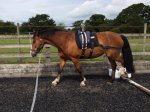SEL
Well-Known Member
she must be super human
if she is so good why has she not found a natural way to work horses, or tell us why so many horses are unsound
She's done a fair few papers looking at causes of lameness. I read one on PSD and conformation. I pretty sure she did the study on rider weight as well. I'm sure a good Google would turn up more.
I'm not sure there is a natural way to work with horses when sitting a rider on their backs is never going to be "natural"!

